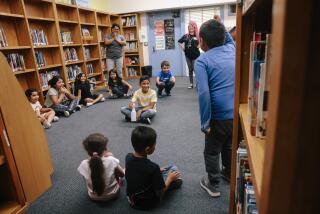REGIONAL REPORT : Summer Interns Bail Out Programs : Jobs: Federal urban aid package provides work and training for young people. It also gives government agencies staffing needed to keep facilities open.
While budget-weary city and county officials across Southern California continue to fret over their fiscal crises, a tiny measure of relief has arisen: the arrival of thousands of summer interns sponsored by the federal government.
This summer’s relief picture began to look better than most officials had anticipated when President Bush signed a $1-billion urban aid package last month, which included $500 million for the summer jobs program.
Millions of that money has been transfused into Southern California, dramatically increasing the number of youths who will get jobs, and the amount of help they provide to their public sector employers.
The interns--low-income youths ranging in age from 14 to 21--provide much-needed assistance each year in city, county and other government departments. For many, the job serves as an introduction to the working world and an opportunity to learn skills for full-time employment.
In some areas, such as Los Angeles, the urban aid package more than doubled the number of slots for summer workers. In others, such as San Diego and Ventura counties, it expanded programs in which job applications have outpaced funding. And in a few instances, as in Riverside, the new money provided staffing that kept some facilities open.
“In this day and age, with the position we are in economically, these kids have been a godsend to us,” said San Diego youth services administrator Rudy Johnson. “Everyone I speak with is very pleased with the program--they keep telling me: ‘The more the merrier.’ ”
Similar comments are echoed by officials across the state as the interns begin their mostly minimum-wage, eight- to 10-week stints.
“When this additional money came forward we were ready,” said Riverside personnel director Wendell Pryor. That enabled the city to react quickly when the 300 additional jobs came up.
“The trick is trying to get them all placed,” Pryor said, comparing the additional workers to “a nice little bird that got dropped in our lap.”
The situation in Los Angeles, which received the second-largest portion of the aid package--New York City got the largest--is described as chaotic. “Things are happening so fast we can’t even give an accurate number of youths we have to place,” said Parker Anderson, director of the Los Angeles Community Development Department.
The urban aid package took Anderson and other officials in the Los Angeles Summer Youth Employment Program by surprise. City officials had planned on providing jobs for about 9,000 workers, Anderson said. Now they must place more than 20,000 by summer’s end.
“There is a serious need in the inner cities of the country for this type of summer youth employment,” he said, “but having this action occur so close to the onset of the summer employment period creates a serious challenge for us.”
In their rush to fill the 35,000 positions across Los Angeles County, administrators have also had to cope with a stipulation tagged onto the urban aid package: Program participants are being forced to sign oaths that they have not been convicted of riot-related crimes.
Almost all job placement officials in Southern California--even those who do not have to deal with the riot stipulation--have reported some degree of difficulty in recruiting and placing workers quickly.
In San Diego County, administrators of the Hire-A-Youth program had anticipated placing 3,250 youths in the federally funded portion of its jobs program, said coordinator Pat Polak.
There were also plans to place another 3,000 youths in private-sector jobs that did not require workers to meet eligibility requirements, which state that participants must come from families whose total income falls below the poverty line, Polak said.
Hire-A-Youth staff members are scrambling to find jobs for an additional 3,000 workers to be funded by the urban aid package, Polak said.
“I don’t think we’ll have a problem finding kids to fill the jobs, with the economy being as tight as it is,” Polak said. “The problem is finding jobs for them. We’ll be placing kids all through the summer,” she said.
Although many jobs provided by the Hire-A-Youth program--and by most of the other summer youth employment programs--are clerical, office work is far from the norm. Participants are engaged in tasks as disparate as removing graffiti, serving as counselors in parks and recreation programs, and serving meals to senior citizens.
DiaRaquel James, a clerical assistant at the Naval Training Center in Point Loma, is a typical example of Hire-A-Youth, said Scott Scheerer of the San Diego Private Industry Council, which administers the program countywide.
James, 15, said her age would almost certainly have prevented her from finding a summer job in her gang-plagued East San Diego neighborhood. Hire-A-Youth gave her a chance to escape the neighborhood for the summer while earning cash she will probably use to buy school clothes, she said.
“I don’t know what I’d be doing if I didn’t have this job,” James said. “Probably sitting home being bored, doing nothing, really,” she said.
Other workers praised the summer jobs program.
Radena Walker, 21, is a Riverside Community College student, one of about 2,000 youths in Riverside County participating in the Youth Employment and Training Program.
Walker, who has been in the summer jobs program since 1985, has progressed to one of the top jobs available--recreational counselor at a youth center for inner-city children. Each day she works with 60 to 80 underprivileged children at the Riverside Settlement Assn. summer day camp.
“I’ve learned all sorts of things in the program, from clerical skills to how to work with underprivileged kids,” Walker said. “My major in school is sociology, so this really corresponds with what I’m studying and what I want to do,” she said.
The city of Riverside may stand to benefit more than others. The city was allotted funding for about 100 jobs before the urban aid package was approved, Pryor said.
Thanks to the new money, it has more than 400 of the county’s nearly 2,000 summer jobs, said Eladio Amores, director of the Riverside County Private Industry Council, which administers the program.
Riverside officials say they are focusing their placement efforts on the city’s parks and recreation department, which was on the verge of cutting back hours at most of its centers because of funding cuts, Pryor said.
“Our major goal now is to find a way with these youth employees to keep the centers open,” Pryor said.
In Anaheim, between 400 and 500 youths will participate in the Anaheim Job Training Program, an increase of more than 200 because of the influx of federal funds, said program analyst Ruben Aceves.
Most youths in the Anaheim program will work for the city, Aceves said, primarily in clerical, maintenance and recreational jobs. The city received about 600 applications; Aceves expects that once those who do not meet the program’s requirements are weeded out, every eligible youth who applied will get a summer job. “It looks like we’re sitting real pretty this year,” he said.
Even more impressive to Aceves than the full employment outlook is about 25% of the youths in last summer’s program were placed in permanent positions when their internships ended, he said.
“A lot of them got to keep doing the jobs for the departments they were working for,” he said.
In Ventura County, about 800 youths, a majority from Oxnard, have been placed in jobs by the Summer Youth Employment Training Program, said coordinator Pamela Macias. The urban aid meant funding for 100 more jobs than planned, including positions with city government, senior citizen meal programs and the U.S. Forest Service.
Doug Spencer, 17, said his job cleaning campsites, emptying fire pits and pulling weeds in Los Padres National Forest was a lot better than most of the opportunities open to him.
“It’s pretty fun work,” Spencer said, describing how he swam across a pond to sand graffiti off a large boulder. “I could be spending the whole summer indoors.”
More to Read
Sign up for Essential California
The most important California stories and recommendations in your inbox every morning.
You may occasionally receive promotional content from the Los Angeles Times.









